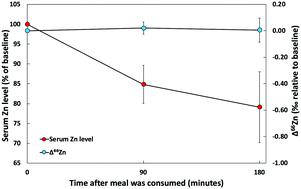当前位置:
X-MOL 学术
›
Metallomics
›
论文详情
Our official English website, www.x-mol.net, welcomes your feedback! (Note: you will need to create a separate account there.)
Postprandial zinc stable isotope response in human blood serum.
Metallomics ( IF 3.4 ) Pub Date : 2020-06-29 , DOI: 10.1039/d0mt00122h Kaj Sullivan 1 , Rebekah E T Moore 2 , Mark Rehkämper 2 , Daniel Layton-Matthews 3 , Matthew I Leybourne 4 , John Puxty 5 , T Kurt Kyser 3
Metallomics ( IF 3.4 ) Pub Date : 2020-06-29 , DOI: 10.1039/d0mt00122h Kaj Sullivan 1 , Rebekah E T Moore 2 , Mark Rehkämper 2 , Daniel Layton-Matthews 3 , Matthew I Leybourne 4 , John Puxty 5 , T Kurt Kyser 3
Affiliation

|
In recent years, considerable advances have been made in the field of medical isotope metallomics, but numerous fundamental physiological processes remain to be investigated. Past studies report that blood serum Zn concentrations decrease by between about 10 and 25%, depending on the size of meal, approximately three hours postprandially (i.e. after eating), before returning to baseline values if no meals are consumed over the following four to five hours. Nine participants were recruited for this study to investigate whether this postprandial Zn concentration decrease is accompanied by a stable isotope response. A baseline serum sample was collected from participants in the morning after overnight fasting. A 576 kcal meal was then provided and additional serum samples were taken 90 and 180 minutes post-meal to coincide with the postprandial response. Serum Zn concentrations decreased postprandially by an average of 21 ± 9% (1SD), but this was not accompanied by a change in stable Zn isotope composition (mean Δ66Zn180-minute-baseline = 0.01 ± 0.09‰, 2SD). We propose that hemodilution and the rapid, efficient postprandial transfer of albumin-bound Zn from serum to the liver and pancreas is responsible for the lack of postprandial serum Zn isotopic response. These results indicate that studies examining solely the distribution of Zn isotopes in serum may obtain samples without considering timing of the most recent meal. However, future studies seeking to compare serum Zn concentrations with δ66Zn values should draw blood samples in the morning after overnight fasting.
中文翻译:

人血清中的餐后锌稳定同位素反应。
近年来,医学同位素金属组学领域取得了相当大的进展,但仍有许多基本生理过程有待研究。过去的研究报告称,血清锌浓度在餐后大约 3 小时内下降约 10% 至 25%,具体取决于进餐量的大小(即进食后),如果在接下来的四到五个小时内没有进食,则在返回基线值之前。本研究招募了 9 名参与者,以调查这种餐后锌浓度降低是否伴随着稳定的同位素反应。在隔夜禁食后的早晨从参与者那里收集基线血清样本。然后提供 576 kcal 餐,并在餐后 90 和 180 分钟采集额外的血清样本,以与餐后反应一致。餐后血清锌浓度平均下降 21 ± 9% (1SD),但这并没有伴随着稳定 Zn 同位素组成的变化(平均 Δ 66 Zn 180 分钟基线= 0.01 ± 0.09‰,2SD)。我们认为血液稀释和餐后白蛋白结合锌从血清到肝脏和胰腺的快速、有效转移是导致餐后血清锌同位素反应缺乏的原因。这些结果表明,仅检查血清中锌同位素分布的研究可能会在不考虑最近一餐时间的情况下获得样本。然而,寻求比较血清锌浓度与δ 66锌值的未来研究应该在隔夜禁食后的早晨抽取血样。
更新日期:2020-06-29
中文翻译:

人血清中的餐后锌稳定同位素反应。
近年来,医学同位素金属组学领域取得了相当大的进展,但仍有许多基本生理过程有待研究。过去的研究报告称,血清锌浓度在餐后大约 3 小时内下降约 10% 至 25%,具体取决于进餐量的大小(即进食后),如果在接下来的四到五个小时内没有进食,则在返回基线值之前。本研究招募了 9 名参与者,以调查这种餐后锌浓度降低是否伴随着稳定的同位素反应。在隔夜禁食后的早晨从参与者那里收集基线血清样本。然后提供 576 kcal 餐,并在餐后 90 和 180 分钟采集额外的血清样本,以与餐后反应一致。餐后血清锌浓度平均下降 21 ± 9% (1SD),但这并没有伴随着稳定 Zn 同位素组成的变化(平均 Δ 66 Zn 180 分钟基线= 0.01 ± 0.09‰,2SD)。我们认为血液稀释和餐后白蛋白结合锌从血清到肝脏和胰腺的快速、有效转移是导致餐后血清锌同位素反应缺乏的原因。这些结果表明,仅检查血清中锌同位素分布的研究可能会在不考虑最近一餐时间的情况下获得样本。然而,寻求比较血清锌浓度与δ 66锌值的未来研究应该在隔夜禁食后的早晨抽取血样。


























 京公网安备 11010802027423号
京公网安备 11010802027423号